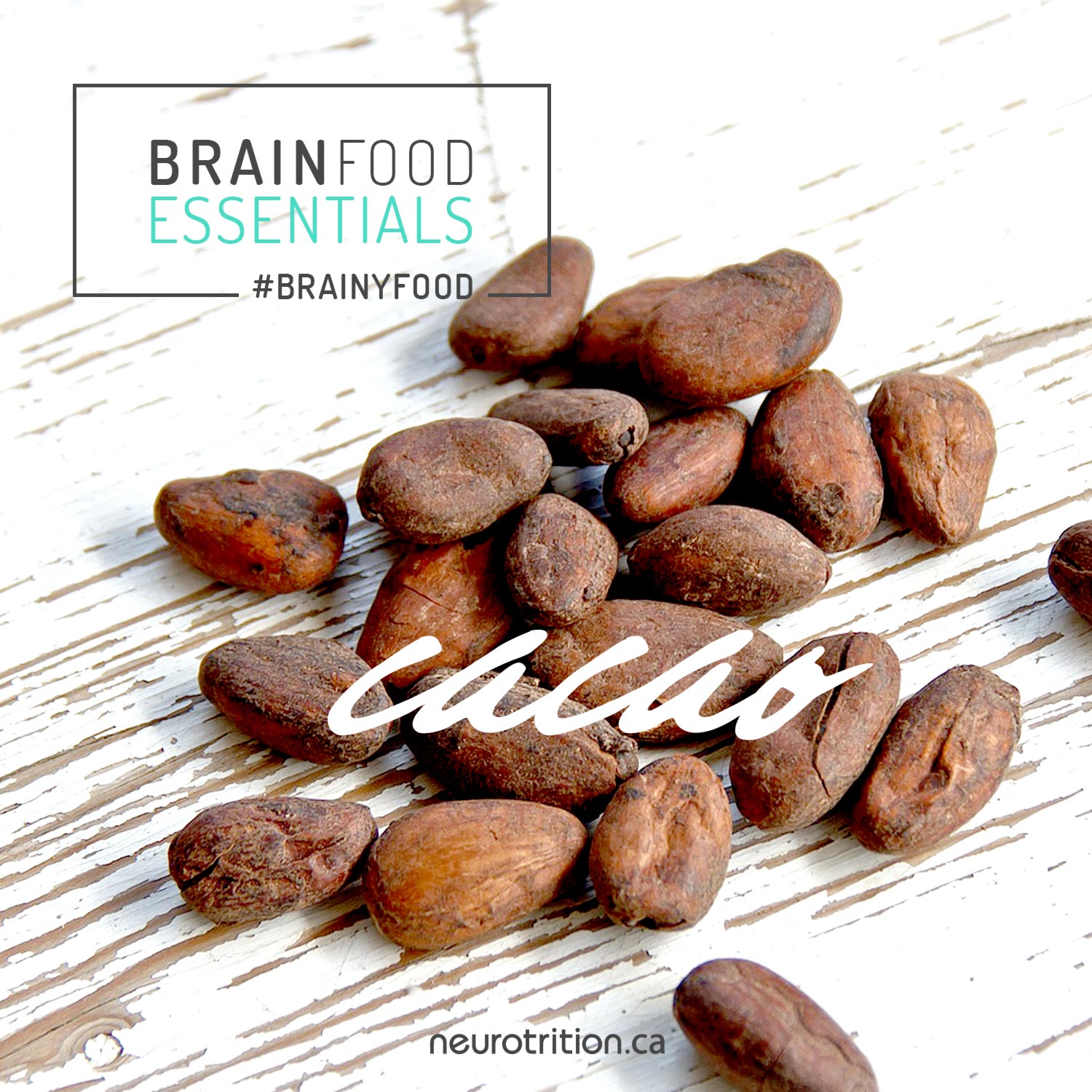Brain Food Essentials :: Cacao

Valentine’s Day is fast approaching and we want to make sure you get all the brainy science to help you choose a “chocolatey” gift for someone you love...or for yourself. ;)
Don’t get me wrong - we’re not talking about the super over-processed, ‘more sugar than chocolate’ kind of “candy bars” you find in convenience stores and gas stations.
We’re talking dark chocolate here. The one with a touch of bitterness in it. The kind you can savour by dissolving it slowly on your tongue.
The bitterness equals the healthfulness! And that bitterness comes from cacao!
The bitterness equals the healthfulness! And that bitterness comes from cacao!
You’ve heard it referred to as “food of the gods”, right? That’s because the Mayans called it “kakawa”, which directly translates to that.
Read on to dive into some of the science behind cacao’s health benefits, as well as a few ways to get more cacao into your life.
“CACAO, COCOA”, JUST LIKE “TOMA(Y)TO, TOMA(H)TO”...OR ARE THEY ACTUALLY DIFFERENT?
It all starts in the seed of the fruit of the theobroma cacao tree.
“Cocoa” is the broad term for all of the food products made from this fruit. Under the term “cocoa” is a wide spectrum of foods ranging from “cacao” which is the least processed, all the way to “candy bars” which are the most processed, have the most added sugar, and are often mixed with milk and other “non-brainy” ingredients.
On Canadian food labels, the terms “cacao” and “cocoa” can be used interchangeably, except in the ingredient listing, where the term “cocoa” or “cocoa powder” must be used.
“Cacao” is the dried and fully fermented fatty cacao seed. You can often find “cacao nibs”, also known as “cocoa liquor,” in health food stores. This is made by grinding, roasting, shelling, and fermenting the cacao beans. These nibs contain both nonfat cocoa solids and cocoa butter.
Cacao in its natural state is bitter due to its high concentration of polyphenols (antioxidant plant compounds that are healthy for you).
Cacao in its natural state is bitter due to its high concentration of polyphenols (antioxidant plant compounds that are healthy for you, more on this later).
This cacao (a.k.a. cocoa liquor) is exactly what is referred to as percent cacao on food labels. The more cacao in the product, the higher the percent, and the darker the colour. This means that more of the nutritional goodness is preserved in the product. This means more antioxidants, minerals, and fibre.
Win-win-win!
Cocoa powder, on the other hand, is made by removing some of the cocoa butter from the liquor, so it contains less fat. Cocoa powder is often treated by “dutching” to neutralize some of its natural acidity. Unfortunately, this process can remove up to 78.5% of the antioxidant polyphenols. Cocoa powder still contains much of the minerals and fibre.
Commercially available “chocolate bars”, or “candy bars” on the other hand, have less cocoa, and more cocoa butter (check the %cacao/cocoa on the labels, the higher the better). They usually include quite a bit of brain-busting sugar too.
In the case of “milk chocolate”, dairy ingredients are also added. This type of chocolate, that you can find just about everywhere, contains only about 10% of the polyphenol-rich cocoa liquor, less than a third of the magnesium, and barely any fibre.
So, as you can see, the term “cocoa” has a huge range of “healthiness”, with cacao being the “brainiest” one (and the one we recommend).
CACAO IS HEALTHY, RIGHT?
Because the umbrella term “cocoa” is what is studied in the scientific research of health effects, that's the term we'll use from now on...just remember that the higher the %cacao/cocoa in the product, the more healthful compounds it contains.
You may be pleasantly surprised to know that there actually IS science behind the hype! Cocoa is indeed healthy for you.
Evidence suggests that daily (high-quality, polyphenol-rich) cocoa consumption may be able to reduce the risk of heart disease!
Evidence suggests that daily (high-quality, polyphenol-rich) cocoa consumption may be able to reduce the risk of heart disease! Cocoa also has positive effects on metabolic disorders, cancer, and, of course, neuro-health!
Let’s get a little “geeky” for a sec, ok?
As mentioned earlier, cocoa is from the plant theobroma cacao, and it contains 380 known chemical compounds, including antioxidant polyphenols (plant chemicals that are healthy for you).
These polyphenols help protect your body from oxidative stress (a.k.a. free radical damage) by increasing the levels of antioxidants in your blood. And when you reduce free radicals in your body, you also reduce the notorious health-buster, inflammation.
Cocoa has a higher antioxidant capacity than green tea, black tea, or red wine. This makes it an amazing brain food!
In fact, cocoa has a higher antioxidant capacity than green tea, black tea, or red wine. This makes it an amazing brain food!
FUN FACT: The antioxidant ability of cocoa powder and unprocessed cocoa beans has been found to be stable, even in 75-year-old samples! (We recommend not keeping them around that long, because you don’t get any health benefits from keeping brain foods in your pantry!)
Cocoa has many positive effects beyond its antioxidant abilities, too. These include: reducing blood pressure, reducing blood thickness (a.k.a. “platelet aggregation”), increasing HDL (a.k.a. “good cholesterol”), and improving insulin resistance.
Cocoa also contains minerals like magnesium, calcium, potassium, iron, copper, and zinc. These minerals are all crucial for optimal brainy functions. For example:
- Magnesium for memory;
- Calcium for nerve cell conduction;
- Potassium to help increase thinking ability and concentration;
- Iron in the blood’s hemoglobin to bring oxygen to the brain; and
- Copper and zinc for brain development.
In addition, cocoa contains both serotonin (the neurotransmitter system that antidepressants act on), and tryptophan (the amino acid used by your body to make serotonin).
And the last of cocoa’s health compounds we’re going to mention here is fibre. Some cocoa products, particularly cacao nibs and cocoa powder can be good sources of fibre. Most of the fibre in cocoa is insoluble, which can act as a gut-friendly “prebiotic” that has brainy benefits we talk about here.
TELL ME MORE ABOUT THE BRAINY BENEFITS
Cocoa contains caffeine, which is a known “psychostimulant” that can reduce the risk of Parkinson’s. But cocoa's brainy benefits go well beyond that.
PRO TIP: Of course, if you’re sensitive to caffeine, or if it affects your sleep, you will want to avoid it before bed, or even after 12:00 p.m. noon.
A lot of the degenerative diseases of the brain are related to oxidation (free radical formation), so it is thought that consuming more antioxidants (hello: cocoa!) might help reduce the risk.
The antioxidants in cocoa have, in fact, been shown to reduce oxidative stress and neuroinflammation, therefore protecting those critical neurons. Some of those antioxidants have even been found to pass the “blood-brain barrier” and enter the brain after eating cocoa. This may help with long-term memory, and reduce the risk of Parkinson’s, Alzheimer’s, and stroke.
Cocoa’s brainy benefits are, in part, due to it’s amazing antioxidant ability, but also because of how it can reduce blood pressure and cholesterol, as well as increase insulin sensitivity. Regulating all of these are important for brain health.
Clinical studies have shown that after eating flavonoid-enriched cocoa, blood flow to the brain can increase. This increased blood supply may help with memory, and help protect against dementia and stroke.
Clinical studies have shown that after eating flavonoid-enriched cocoa, blood flow to the brain can increase. This increased blood supply may help with memory, and help protect against dementia and stroke.
Some studies also show that people who consume more chocolate tend to feel less stress and have a better sense of “wellbeing.”
PRO TIP: If cocoa happens to trigger headaches or other health concerns for you, then you may best avoid it. Don’t worry though, there are tons of other delicious and healthy brain foods! Check out some of our Neuro-Team’s favourites by clicking on our photos here.
YOU DON’T NEED TO TELL ME HOW TO GET MORE COCOA INTO MY LIFE...BUT YOU CAN IF YOU WANT TO
Here at the NeuroTrition kitchen, we just love coming up with brainy recipes for maximum nutrition and neuro-health.
If you like minty chocolate, you’ll love our peppermint tea or espresso recipes, here. Plus, we’ve got a homemade peppermint mocha syrup that is out of the world, here.
If hot cocoa is more your thing, then you’ll love the brain boosting one we created just for you, here.
Enough with the drinks...how can we EAT more of this amazing brain food?
Why not try our avocado superfood pudding, here? Or even this decadent dark chocolate ganache, here?
No matter how you like it, the bottom line is that you want your chocolate to be dark and have as high a percent of cacao/cocoa in it as possible (at least 70%). After all, the bitterness equals the healthfulness. And this truly is based on the nutrition science and neuroscience.
Your brain will thank you!
- References
-
- Andújar, I., Recio, M.C., Giner, R.M. & Ríos, J.L. (2012). Cocoa polyphenols and their potential benefits for human health. Oxid Med Cell Longev. 2;2012:906252.
- Bisson, J.F., Nejdi, A., Rozan, P., Hidalgo, S., Lalonde, R. & Messaoudi, M. (2008). Effects of long-term administration of a cocoa polyphenolic extract (Acticoa powder) on cognitive performances in aged rats. Br J Nutr. 100(1):94-101.
- Canada Food Inspection Agency. Labelling Requirements for Confectionery, Chocolate and Snack Food Products. Common Name
- Costa, J., Lunet, N., Santos, C., Santos, J. & Vaz-Carneiro, A. (2010). Caffeine exposure and the risk of Parkinson's disease: a systematic review and meta-analysis of observational studies. J Alzheimers Dis. 2010;20 Suppl 1:S221-38.
- De Araujo, Q.R., Gattward, J.N., Almoosawi, S., Silva, M., Dantas, P.A. & De Araujo, Júnior Q.R. (2016). Cocoa and Human Health: From Head to Foot--A Review. Crit Rev Food Sci Nutr. 56(1):1-12.
- Grassi, D., Ferri, C. & Desideri, G. (2016). Brain Protection and Cognitive Function: Cocoa Flavonoids as Nutraceuticals. Curr Pharm Des. 22(2):145-51.
- González, H.F. & Visentin S. (2016). Micronutrients and neurodevelopment: An update. Arch Argent Pediatr. 114(6):570-575.
- Katz, D.L., Doughty, K. & Ali, A. (2011). Cocoa and chocolate in human health and disease. Antioxid Redox Signal. 15(10):2779-811.
- Larsson, S.C. (2014). Coffee, tea, and cocoa and risk of stroke. Stroke. 45(1):309-14.
- Nehlig A. (2013). The neuroprotective effects of cocoa flavanol and its influence on cognitive performance. Br J Clin Pharmacol. 75(3):716-27. doi: 10.1111/j.1365-2125.2012.04378.x.
- Sokolov, A.N., Pavlova, M.A., Klosterhalfen, S. & Enck, P. (2013). Chocolate and the brain: neurobiological impact of cocoa flavanols on cognition and behavior. Neurosci Biobehav Rev. 37(10 Pt 2):2445-53.










